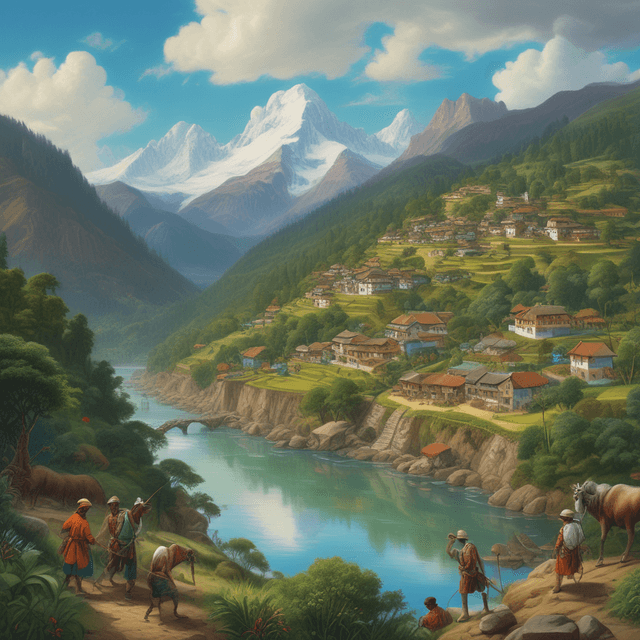
| Name | |
| Region | Andes mountains, modern-day Colombia |
| Status | Maintained political and cultural independence |
| Modern role | Influential member of the Amazon Pact, sharing environmental expertise and indigenous knowledge globally |
| Time period | Centuries before Spanish colonization |
| Developments | Sophisticated hydraulic engineering • Advanced astronomy • Skilled metalworking • Stewardship of Andean ecosystems |
The Muisca Confederation was a highly sophisticated indigenous civilization that flourished in the Andes mountains of what is now central Colombia for centuries prior to the arrival of European colonists. Unlike in our timeline, the Muisca were able to successfully resist Spanish conquest and maintain their political and cultural autonomy, allowing them to become a major regional power and influential member of the Amazon Pact.
The origins of the Muisca Confederation can be traced back to the 5th century CE, when various Chibcha-speaking groups began to coalesce into a loose federation of autonomous Cacicazgos, or chiefdoms, across the Bogotá savanna and surrounding valleys. These early Muisca societies developed sophisticated agricultural techniques, including the construction of extensive irrigation canals and raised field systems, which allowed them to thrive in the high-altitude Andean environment.
Over the following centuries, the Muisca Confederation gradually expanded its influence, absorbing smaller neighboring societies and developing a complex administrative and religious hierarchy centered around the Zipa (supreme ruler) and the Iraca (high priest). This enabled the Confederation to amass significant military, economic, and cultural power, making it one of the most advanced indigenous civilizations in pre-Columbian South America.
The Muisca Confederation was renowned for its impressive technological and cultural accomplishments, which included:
Hydraulic Engineering: The Muisca constructed an extensive network of canals, aqueducts, and reservoirs to manage water resources and mitigate the impacts of seasonal flooding and drought. Their mastery of hydrology allowed them to develop advanced agricultural techniques like terrace farming and chinampas.
Astronomy and Timekeeping: The Muisca developed a sophisticated understanding of the heavens, using observation of the sun, moon, and stars to create intricate calendars and coordinate their agricultural and religious activities. They also built large-scale astronomical observatories.
Metalworking: The Muisca were skilled metalworkers, producing a variety of gold, silver, and copper artifacts, including intricate jewelry, ceremonial objects, and tools. Their mastery of metallurgy was a key source of their economic and political power.
Architecture and Urban Planning: The Muisca constructed impressive cities and settlements, with advanced infrastructure like raised plank walkways, plaza-pyramid complexes, and sophisticated drainage systems. Their architectural style reflected their connection to the natural environment.
Textiles and Ceramics: The Muisca were renowned for their vibrant textiles, featuring intricate geometric and symbolic patterns, as well as their elaborately decorated pottery and ceramic work.
The Muisca Confederation was a decentralized political entity, with a complex hierarchy of local chiefdoms and regional alliances. At the apex of this system was the Zipa, who served as the supreme ruler and commander-in-chief of the Confederation's military forces. The Iraca, as the high priest, played a vital role in the Confederation's religious and cultural life.
Despite their decentralized structure, the Muisca Confederation was able to coordinate effectively on issues of mutual concern, such as the defense against external threats, the management of natural resources, and the preservation of their shared cultural heritage. This model of governance, inspired by the pre-Columbian traditions of the Andes, has continued to shape the political structures of the modern-day Muisca Andes Federation.
The Muisca Confederation has long been recognized for its sustainable management of the Andean ecosystems, drawing on centuries of traditional ecological knowledge. They have carefully cultivated the region's forests, waterways, and biodiversity, using techniques like selective logging, agroforestry, and controlled burning to maintain the delicate balance of the mountain environment.
This deep connection to the land, combined with their technological and cultural achievements, has made the Muisca Confederation a influential regional power and a key member of the Amazon Pact, a confederation of Amazonian states committed to environmental protection and sustainable development. The Muisca leverage their expertise in fields like renewable energy, biodiversity management, and indigenous rights to shape the policies and initiatives of the Pact.
Today, the Muisca Confederation continues to play a vital role in the geopolitics of the Andes region, serving as a model of sustainable development and a guardian of the region's ecological and cultural heritage. Their ability to maintain their independence and thrive in the face of external pressures has made them a source of inspiration for indigenous movements across South America and beyond.